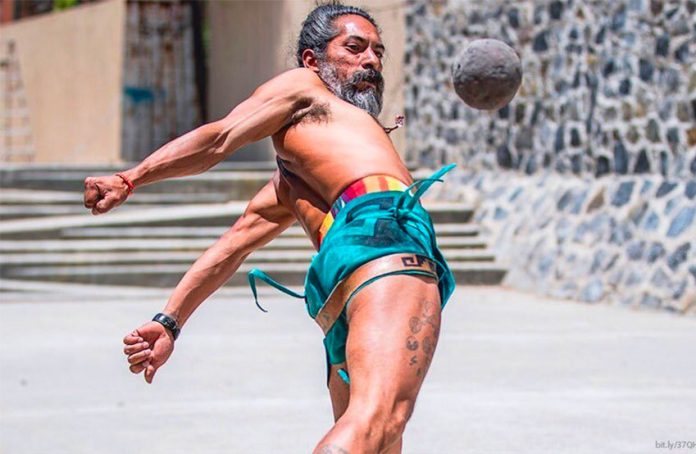The National Autonomous University of Mexico (UNAM) has decided to play ball, establishing research and sports teams dedicated to the conservation and promotion of the Mesoamerican ballgame.
Many people are aware of the ancient game because of the over 1,000 ball courts which have been excavated at numerous sites from central Mexico into Central America. The game was an important part of the Olmec, Mayan, Toltec and Teotihuacan as well as Aztec civilizations. The Náhuatl word for the game is ulama, or “hip” and the ball pok ta pok.
What most people do not know is that the game is still played today.
The focus of the game is a large solid rubber ball that can weigh as much as 3 kilograms. It is moved around the court by bouncing off the players’ hips as they try to get it into the appropriate ring.
The first team is a multidisciplinary group of researchers looking to recover exactly how the rubber ball was made in the past. The team includes Emilie Carreón and Nora Pérez of the Institute for Aesthetic Research (IIE), as well as Baldomero Esquivel, Marisol Reyes, Mayra León and Everardo Tapia of the National Laboratories for Research and Conservation of Cultural Heritage, along with others from the School of Physics and modern-day players.
The exact composition and techniques for making the ball in the past are not known. The team is attacking the problem from several directions. One is to survey indigenous communities to find out what knowledge survives with them to the present day. Another is to work with players to know the exact requirements of the ball to determine the chemical characteristics it needs to have. Another is to analyze information already in the archaeological data, including some balls that do survive from the pre-Hispanic period, without damaging them.
It is known that the balls were made from the sap of the Panama rubber tree. Putting all the information together, the team intends to “… conserve ancestral knowledge, and propose a technique for the manufacture of balls for players.” stated Emilie Carreón.
The project is known by the long academic name of “Manufacture of the rubber ball of the Mesoamerican Ulama (or hip) game. Recovery of the techniques through its material characteristics,” but its aims are anything but boring.
UNAM hopes to get the game declared intangible cultural heritage by UNESCO and encourage more communities to revive the playing of the game.
Today, the game is played in different parts of Latin America and now there is a World Cup of Mesoamerican Ancestral Ball Sport. It was created in 2015 and include teams from Mexico, Belize, El Salvador, Honduras, Panama and Guatemala.
In Mexico alone, there are now leagues associated with Olmec, Mayan, Otomi, Teotihuacan, Tlaxcala, Chiapas and Aztec cultures.
The game was witnessed by the conquistadors and evangelists who marveled at the ball’s elasticity and bounce. “They had never seen any ball like it, which bounced much more than those made of hair or inflated bladders, which were usual in the Old World.” However, that did not stop these same Europeans from prohibiting the game once they took control.
Despite the prohibition, the game survived underground in some areas in the northwest of the country. In the 1980s, filmmaker Roberto Rochin produced Ulama in the state of Sinaloa to document the ancient practice, as well as the making of the ball. This same filmmaker is also part of the research team.
Students from the Schools of Philosophy and Letters and from the School of Chemistry are also in on the project, having established their own team at the University City campus in Mexico City in February 2020. The teams are still in formation and members of the public are invited to inquire. They can be seen practicing at the basketball and volleyball courts on Tuesdays and Thursdays at the campus.
“It is a diverse community, which comes together on the field and looks to preserve this game, with emphasis on the making of the rubber ball.” asserted Daniel Santiago Luna, the coach for the university players.
Mexico News Daily
